You’ll need seven essential hand tools to create professional jewelry: flat nose pliers for wire manipulation and jump rings, round nose pliers for loops and curves, chain nose pliers for precision gripping, bent nose pliers for tight spaces, wire cutters for clean cuts, flush cutters for professional finishing, and nylon jaw pliers to protect metal surfaces from scratches. These specialized tools enhance your control and efficiency while ensuring quality results. Mastering each tool’s unique capabilities will elevate your craftsmanship considerably.
Flat Nose Pliers for Wire Manipulation and Jump Ring Work
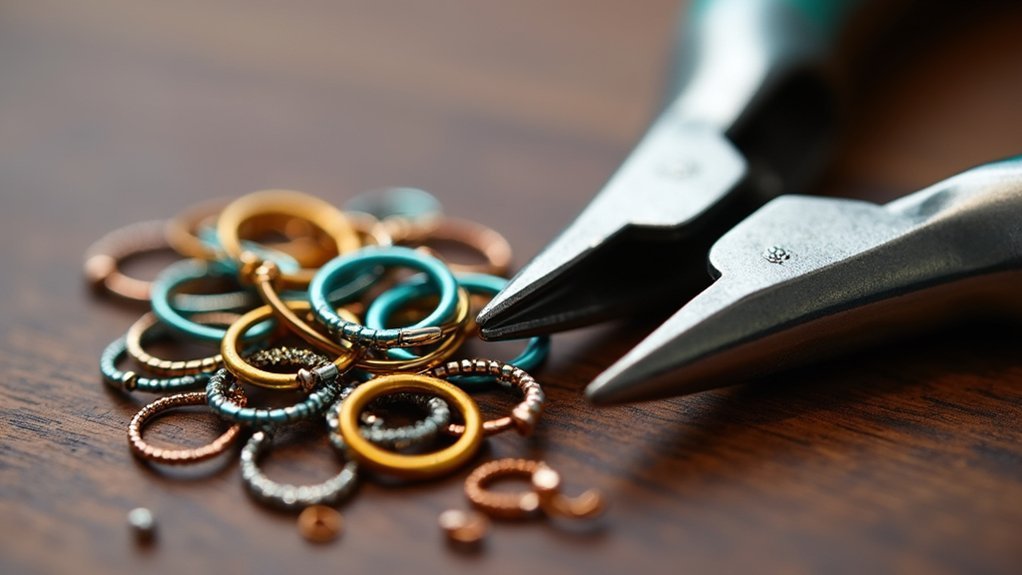
Among the most versatile tools in your jewelry-making arsenal, flat nose pliers excel at wire manipulation and jump ring work that forms the foundation of countless designs.
Flat nose pliers stand as essential jewelry-making tools, delivering unmatched precision for wire work and jump ring manipulation in every project.
You’ll find their flat inner jaws provide exceptional grip strength, allowing you to hold findings securely while crafting intricate pieces. When opening and closing jump rings, these pliers enable smooth connections without damaging delicate metals.
For ideal results, invest in two pairs of flat nose pliers to prevent crimping during wire-wrapping techniques. This approach guarantees clean, professional finishes on your completed pieces.
Choose pliers with smooth jaw surfaces to avoid scratching your jewelry components. Whether you’re a beginner learning basic techniques or an experienced maker tackling complex projects, flat nose pliers remain indispensable for precise wire manipulation and reliable jump ring connections.
Round Nose Pliers for Creating Loops and Curves
While flat nose pliers handle straight wire work beautifully, round nose pliers become your go-to tool for creating the curved elements that bring jewelry designs to life.
These essential pliers feature conical jaws that let you craft wire loops in various sizes, making them perfect for both beginners and experienced makers.
You’ll want to start with the wider jaw section for larger loops, then move toward the tip for smaller, more precise curves.
Round nose pliers aren’t just for basic loops—you can create clasps and jump rings to connect different jewelry components.
Choose pliers with smooth jaws to prevent wire damage and unsightly marks on your metal, ensuring your finished pieces maintain their professional appearance.
Wire Cutters for Clean and Precise Cuts
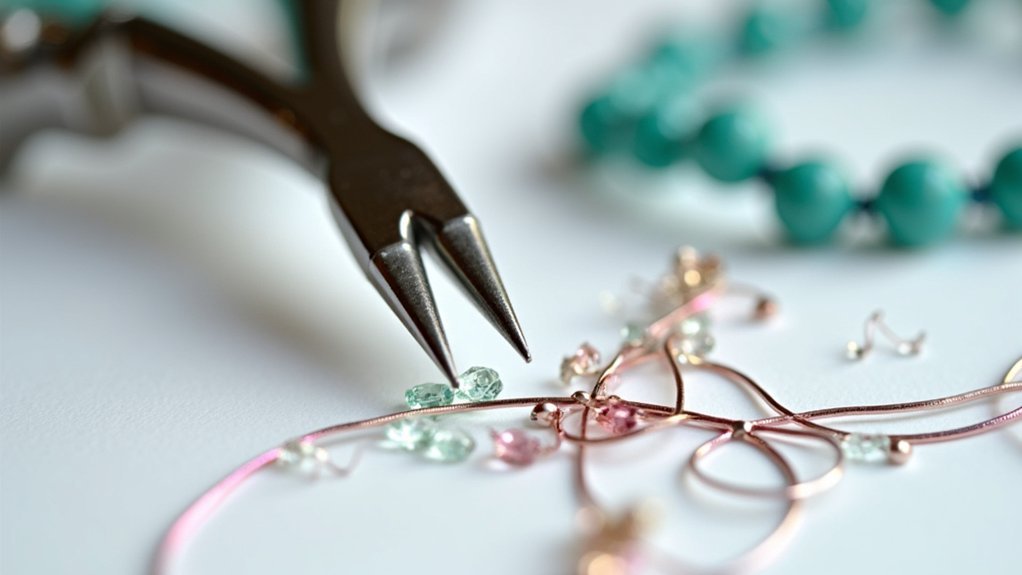
You’ll find several types of wire cutters available, with flush cutters being your best choice for creating clean cuts without sharp wire ends.
Quality brands like Swanstrom and Lindstrom offer superior durability and performance compared to cheaper alternatives that wear out quickly on thicker gauges.
Mastering proper cutting techniques won’t just improve your results—it’ll also extend your tools’ lifespan and maintain their cutting efficiency over time.
Types of Wire Cutters
Several types of wire cutters can transform your jewelry-making precision, but choosing the right one makes all the difference in achieving clean, professional cuts.
Flush cutters are your go-to tool for wire-wrapping techniques, designed to cut wire flush against surfaces while leaving no sharp edges. These specialized cutters create seamless finishes that elevate your work’s professional appearance.
Regular wire cutters work well for general cutting tasks, but they’re not ideal for precision work. When selecting wire cutters, match the tool to your wire gauge – using inappropriate cutters damages both your equipment and materials.
Quality brands like Swanstrom and Lindstrom offer superior durability, especially when working with thicker gauges. Remember, the right cutter prevents frayed ends and guarantees consistently clean results.
Choosing Quality Brands
Three key factors separate professional-grade wire cutters from budget alternatives: blade precision, material quality, and construction durability. When you’re selecting wire cutters, brands like Swanstrom and Lindstrom consistently deliver good quality tools that’ll enhance your jewelry-making experience.
| Brand | Key Features | Price Range |
|---|---|---|
| Swanstrom | Precision blades, ergonomic handles | $$$ |
| Lindstrom | Swedish steel, exceptional durability | $$$$ |
| Generic | Basic cutting, limited lifespan | $ |
You’ll find that investing in reputable brands pays off through superior cutting performance and extended tool lifespan. Quality wire cutters maintain their sharpness longer, requiring less frequent replacement. Choose models designed for your specific wire gauges to prevent premature wear. Remember, good quality tools ultimately save money while improving your craftsmanship results.
Proper Cutting Techniques
Having the right wire cutters means nothing without proper technique to maximize their performance. Position your cutters perpendicular to the wire and apply steady, even pressure for smooth, clean cuts.
Choose cutters appropriate for your wire gauge—cutting wire that’s too thick will damage the blades and create uneven cuts.
For professional results, use flush cutters when you need clean finishes without protruding sharp ends. These cutting techniques prevent wire fraying and damage while ensuring precision in your jewelry work.
Maintain your cutters through regular cleaning and oiling to preserve their cutting efficiency and extend their lifespan.
Master these fundamental cutting techniques, and you’ll achieve the clean, precise cuts essential for quality jewelry making every time.
Chain Nose Pliers for Gripping and Bending
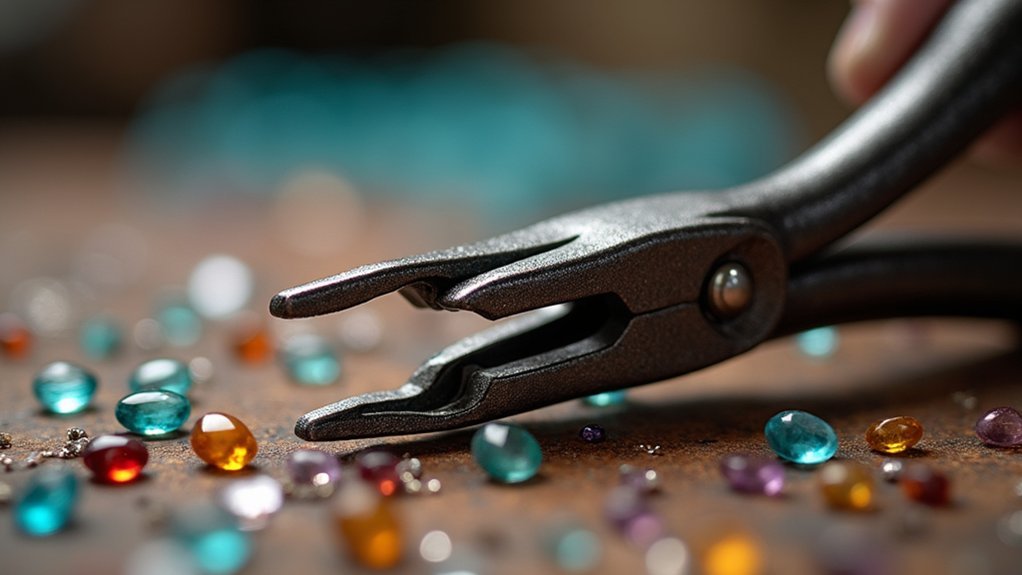
While many pliers serve similar functions, chain nose pliers stand out as the workhorse of jewelry making due to their distinctive flat inner jaws and rounded outer surfaces. This design allows you to grip and bend metal wire with precision while maintaining control over delicate components.
Their tapered shape gives you access to tight spaces, making them perfect for manipulating small findings and creating intricate designs.
You’ll use these versatile tools for opening jump rings, finishing wire-wrapped ends, and creating sharp bends in your projects.
Invest in at least two pairs to avoid crimping metal during complex techniques.
When shopping, choose chain nose pliers with smooth jaw surfaces to prevent scratching your materials and guarantee professional-quality results.
Flush Cutters for Professional Wire Finishing
Once you’ve mastered gripping and bending wire with chain nose pliers, you’ll need flush cutters to achieve clean, professional cuts that complete your jewelry pieces.
These specialized tools create smooth edges without sharp protrusions, delivering the polished finish that distinguishes amateur work from professional jewelry making.
Flush cutters excel with 20-gauge to 30-gauge wire, where their unique blade design cuts flush against surfaces without damaging adjacent components.
Unlike standard wire cutters, they eliminate unsightly sharp ends that compromise your finished pieces’ appearance.
Invest in high-quality brands like Swanstrom and Lindstrom for durability and consistent performance.
These tools withstand frequent use without dulling, making them essential for serious jewelry makers who demand precision and professional results in every project.
Nylon Jaw Pliers for Protecting Metal Surfaces
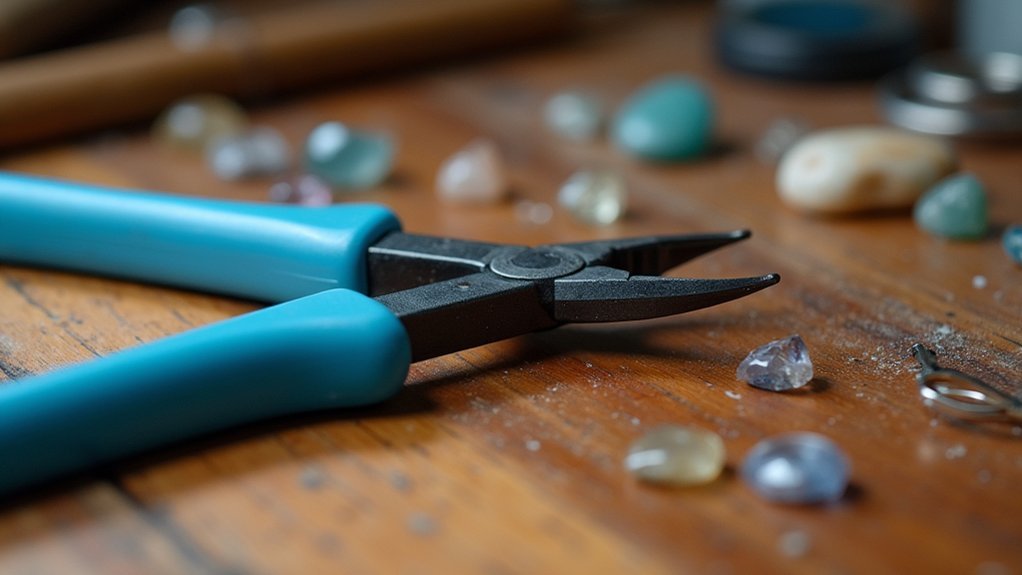
When you’re working with precious metals and delicate wires, nylon jaw pliers become your best friend for maintaining pristine surfaces.
You’ll find these specialized pliers prevent unsightly scratches and marks that traditional metal-jaw tools often leave behind.
They’re also perfect for smoothing out stubborn kinks in wire while providing a secure, damage-free grip that won’t compromise your carefully crafted pieces.
Prevents Wire Scratches
Since traditional pliers can leave unsightly scratches and dents on precious metals, nylon jaw pliers become an indispensable tool for protecting your jewelry’s surface integrity. The soft, non-marring jaws create a secure grip on wire without causing damage that would require additional polishing or repair work later.
When you’re working with delicate metals like gold and silver, these pliers prevent the frustrating scratches that standard metal jaws typically leave behind. You’ll maintain the pristine finish of your materials while still achieving the firm hold needed for precise manipulation.
This protection is especially vital during intricate bending and shaping tasks where you need multiple grip adjustments. By preventing surface damage from the start, you’ll save time on finishing work and guarantee your completed pieces maintain their professional appearance.
Smooths Metal Kinks
Beyond preventing surface damage, nylon jaw pliers excel at smoothing out unwanted kinks and irregular bends that inevitably occur during wire work.
When you’re shaping sterling silver or other soft metals, these pliers are used to gently massage out imperfections without creating new ones. The nylon tips distribute pressure evenly across the metal’s surface, allowing you to work metal without leaving telltale marks that traditional steel pliers would create.
You’ll find these pliers invaluable when straightening bent wire or refining curves in your jewelry pieces.
Their gentle grip lets you make subtle adjustments repeatedly until you achieve the perfect shape. The replaceable nylon tips guarantee consistent performance, maintaining that smooth, polished appearance your finished jewelry deserves while preserving your metal’s original luster.
Grips Without Damage
Although traditional steel pliers deliver the grip strength you need for jewelry making, they’ll inevitably scratch, dent, or mar your precious metals during manipulation.
Nylon jaw pliers solve this problem by providing firm grip without surface damage. These specialized tools feature protective nylon tips that won’t leave marks on delicate metals like silver and gold-filled wire. You’ll achieve precise bends and movements while maintaining your project’s pristine finish.
The replaceable nylon tips extend the tool’s lifespan and preserve its protective qualities over time. Whether you’re a beginner or experienced maker, nylon jaw pliers are essential for working with softer metals where traditional jaws would cause unwanted deformation, making jewelry creation smoother and more professional.
Bent Nose Pliers for Hard-to-Reach Areas
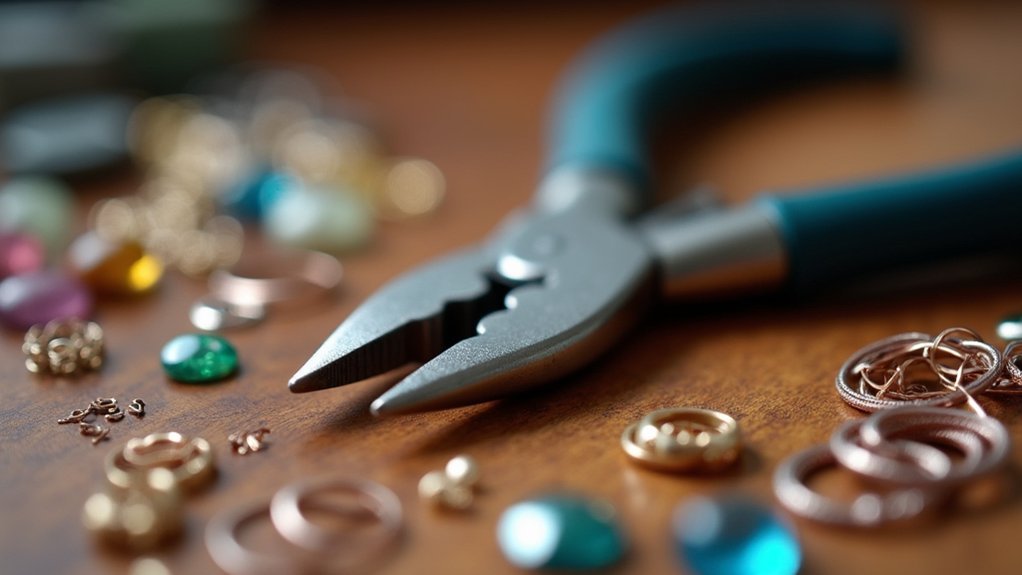
When you’re working on intricate jewelry designs, bent nose pliers become invaluable for accessing tight spaces that standard straight-nose pliers can’t reach. Their angled jaws let you maneuver around other components without blocking your view of the workpiece, giving you better control over delicate operations.
You’ll find these pliers essential when bending wire in confined areas or opening jump rings within complex assemblies. The smooth inner surfaces protect your materials from scratches and marks while you work on detailed components of your piece of jewelry.
Beyond accessing tight spots, bent nose pliers excel at gripping, holding, and positioning small elements with precision. They’re versatile enough for both beginners learning fundamental techniques and experienced makers tackling sophisticated designs, greatly improving your workflow efficiency.
Frequently Asked Questions
What Are the Basic Tools Needed for Jewelry Making?
You’ll need pliers for gripping and bending, wire cutters, a jeweler’s saw for cutting metal, measurement tools like rulers, soldering equipment including a torch, and polishing papers for finishing your pieces.
What Should I Buy to Start Making Jewelry?
You’ll need flat nose pliers, round nose pliers, wire cutters, a jeweler’s saw with blades, soldering block, gas torch, polishing papers, and measuring tools like calipers for precise work.
What Equipment Do You Need to Be a Jeweler?
You’ll need basic pliers, wire cutters, a jeweler’s saw, soldering torch, measuring tools, and polishing equipment. These essential tools let you cut, shape, join, and finish metal components for creating professional jewelry pieces.
How Profitable Is Jewelry Making?
You can achieve 50-80% profit margins in jewelry making. The handmade market’s worth $32 billion and growing. With minimal startup costs, you’ll quickly scale from hobbyist to entrepreneur, especially selling custom pieces online.
In Summary
You’ve now got the essential pliers and cutters you’ll need to tackle most jewelry-making projects. Start with these seven tools, and you’ll be able to manipulate wire, create professional loops, make clean cuts, and handle delicate pieces without damage. Don’t feel pressured to buy everything at once—build your collection gradually as your skills develop. With quality tools in hand, you’re ready to bring your jewelry designs to life.



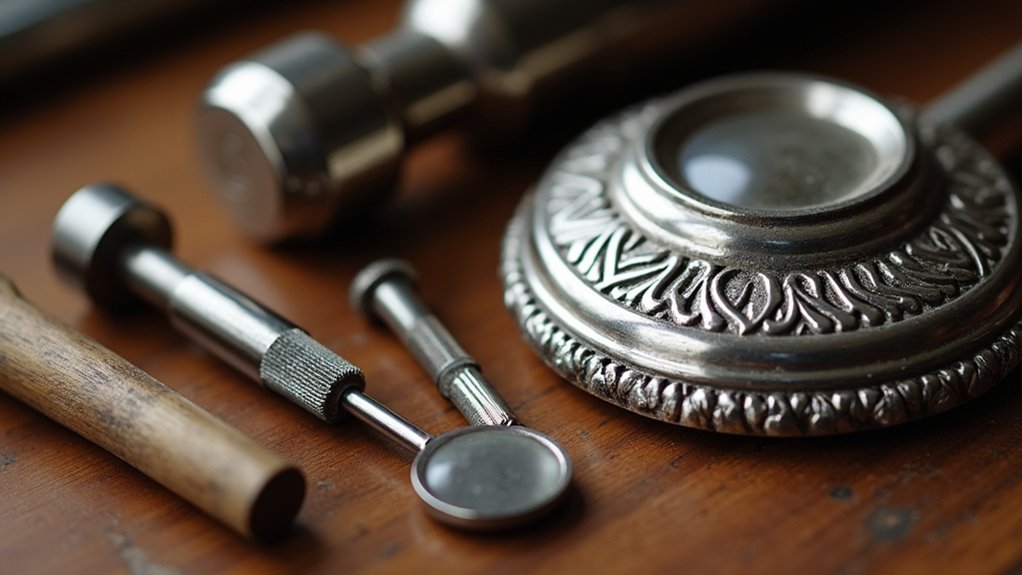

Leave a Reply